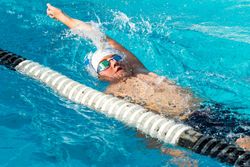How To Get Your Child To Be More Active

Maintaining a healthy fitness level is crucial for the health of everyone in your family, especially your children. How physically fit and active your child is now will influence their development and future health. However, it can be difficult to get them to be as active as they should be. Below is a brief guide to the importance of childhood fitness, as well as some advice on how to encourage your children to be more active.
Why Is Childhood Fitness Important?
Staying fit and physically active will help your child reach healthy developmental milestones, particularly cognitive ones. Being fit and active has been shown to improve children’s cognitive functions – including memory, mental flexibility, and thinking skills – and boost overall brain health.
Beyond the immediate mental and physical benefits, a healthy, active childhood sets your child up for a healthier future and prevents major diseases. Obesity and physical inactivity during childhood has been linked to higher risks of cardiovascular disease later in life. Childhood fitness is also critical to the development of a strong skeletal system and preventing osteoporosis, with more physical activity in childhood linked to lasting improvements in bone mass, mineralization, length, and structure. Fostering high activity levels and healthy habits from a young age ensures they carry them throughout their lifetime, instead of battling to overcome the disadvantages of childhood sedentariness and stagnation.
What Can You Do To Help?
 The key to getting your child invested in physical activity is to find activities that cater to their interests. If your child likes competitive sports, sign them up for a soccer or basketball team. For children who don’t like sweating or sports, other activities like swimming, walking, and biking will provide physical activity with minimal discomfort. For those that are more artistically or musically inclined, you could encourage them to take up dancing or performance art. Children that prefer reading, writing, or watching television might benefit from at-home workout equipment, such as a treadmill or bike, that allows them to read or write while they exercise, even if it’s in audio format (such as listening to audiobooks or recording their thoughts on a voice recorder). Strategies for increasing your child’s activity and fitness levels should be discussed with your child and their general or osteopathic physician to ensure everyone’s on board.
The key to getting your child invested in physical activity is to find activities that cater to their interests. If your child likes competitive sports, sign them up for a soccer or basketball team. For children who don’t like sweating or sports, other activities like swimming, walking, and biking will provide physical activity with minimal discomfort. For those that are more artistically or musically inclined, you could encourage them to take up dancing or performance art. Children that prefer reading, writing, or watching television might benefit from at-home workout equipment, such as a treadmill or bike, that allows them to read or write while they exercise, even if it’s in audio format (such as listening to audiobooks or recording their thoughts on a voice recorder). Strategies for increasing your child’s activity and fitness levels should be discussed with your child and their general or osteopathic physician to ensure everyone’s on board.
If injuries occur during your child’s fitness activities, bring them to the skilled team at IMUA Orthopedics Sports & Health in Honolulu, HI. Their prestigious osteopathic physician team specializes in sports medicine, orthopedic surgery, osteopathic manipulation, and lifestyle guidance, so they’ll take care of your child’s bone injuries or nutritional deficiencies with advanced methods in a calming setting. Together, all of you can ensure that your child is set up for a healthy, strong future. Learn about their services online and call (808) 521-8170 to schedule an appointment.
About the Business
(12 reviews)
Have a question? Ask the experts!
Send your question

